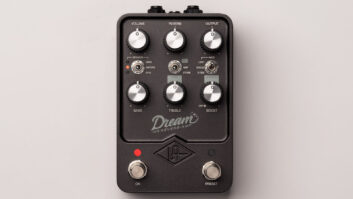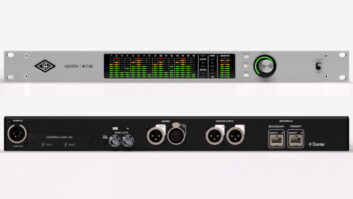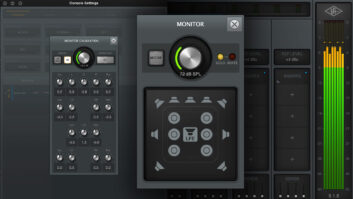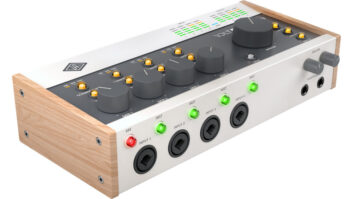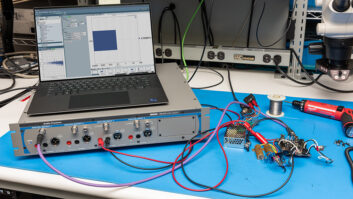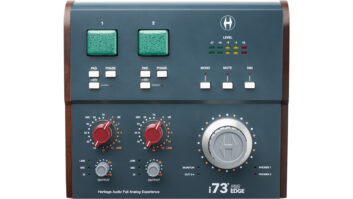
Bill and James Putnam brought smiles to a lot of studio engineers in 1999, when they announced the relaunch of Universal Audio, which had shut down 30 years prior. The first two projects the new company undertook were the production of virtually exact replicas of the seminal Teletronix LA-2A and UREI 1176 LN, two of the most highly sought-after vintage compressors of all time. With the introduction of their Model 2-610 Microphone Preamplifier ($2,295 list), Universal Audio has ventured into new territory. The 2-610 is the new company’s first original analog design.
That’s not to say that the 2-610 doesn’t possess vintage heritage. This new tube mic pre was inspired by the mic preamp section of the ’60s-era Universal Audio 610 recording console. That board — the first modular console design — left its indelible sonic imprint on many recordings by Frank Sinatra and Sarah Vaughan, as well as the Beach Boys’ Pet Sounds, The Doors’ L.A. Woman and Van Halen’s debut album. In fact, the console is still in use at Ocean Way Studios, where it lends its distinctive sound to projects by the Goo Goo Dolls, No Doubt, Green Day and others.
Go to the Focus on Universal Audio page to see video and learn more about UA products.
The 2-channel 2-610 attempts to preserve what is timeless about the 610 console’s mic pre section, but it updates components and features to bring the mic pre up to today’s standards. The same 12AX7A and 6072A tubes (one per channel) are used, as are identical componentry values and many of the legacy module’s features. Modern updates include a higher-quality power supply, polypropylene caps, metal film resistors, custom-wound I/O transformers with double-sized alloy cores, and newly added features such as switchable polarity inversion, phantom power, high-impedance inputs and an enhanced EQ section.
Even considering Universal Audio’s unequivocal success with prior product releases and the glowing legacy of the 610 console, I could not have anticipated the impact the 2-610 would have on my recording session. What I heard blew me away like a hurricane. But before I gush volumes of praise for this amazing product, let’s take a tour of its feature set.
DOUBLE FEATURES
The two-rackspace 2-610’s generous allotment of mic, line and instrument I/Os encourage creative uses beyond mic signal preamplification. The rear panel has a line input for each channel in addition to the expected mic in/line out — all transformer-balanced on XLRs. Besides the detachable AC cable socket, the only other connectors are ¼-inch, high-impedance jacks on the front panel for patching in guitar, bass or other electronic instruments.
The control layout for both channels is identical. All knobs and switches have a smooth feel and positive action. You choose which input you want to use — mic/line/DI — via a 5-position rotary switch. Mic and DI inputs are each allocated two switch positions, each presenting a different input impedance. You can choose between 500-ohm and 2.0-kilohm impedance for the mic input, and either 47 kilohms or 2.2 megohms for DI.
Changing the impedance results in a different sound, of course. For example, active basses and guitars might sound best on the 47-kilohm setting, whereas passive instruments with magnetic or piezo pickups will benefit from the reduced loading that the 2.2-megohm setting affords. The optimal mic impedance setting varied according to which mic I was using, with the best setting resulting in a more open and focused sound. My Demeter VTDB-2b Tube Direct and Aguilar DB 900 tube DI boxes both sounded best using the 500-ohm mic input setting. It’s really great having the flexibility to match the 2-610’s impedance to various sources to sculpt the sound.
You’ll notice two different gain controls for each channel on the 2-610’s front panel, one marked Gain and the other Level. These each serve a separate, single-ended, Class-A, dual-triode gain stage inside the unit. Variable negative feedback is applied to both gain stages. Total maximum gain is 61 dB, ample for most situations.
The Gain control is a 5-position rotary switch that adjusts the gain of the input stage in 5dB increments. As you turn this switch clockwise, negative feedback is reduced and gain increases, along with pleasing harmonic distortion. Conversely, turning this switch counterclockwise decreases the gain and yields a cleaner sound.
The Level control is a large, continuously variable rotary knob that determines how much level is sent from the preamp stage to the output stage; a master volume control, if you will. I got some really smooth and musical distortion effects on electric guitar, bass and drums by lowering this control and cranking the Gain switch. Generally, for the cleanest sounds, the level control should be set between 7 and 10 (full clockwise) while adjusting the Gain switch for optimal output level.
Both channels feature independent high- and low-shelving EQ facilities. Two three-way toggle switches select a fixed-corner frequency for each band (70/100/200 Hz for the lows and 4.5/7/10 kHz for the highs) with up to 9dB boost/cut available via 11-position rotary switches. With all EQ nulled, the 2-610’s frequency response is 20 to 20k Hz ±1 dB.
Each channel has switches for 48-volt phantom power and polarity reversal, with the latter switching the rear panel line out (normally pin 2 hot) to pin 3 hot when the polarity is set to Out, or inverted. A beefy power switch on the front panel is accompanied by a lamp with a huge purple lens, a nice aesthetic touch. In fact, the entire unit oozes retro-cosmetic appeal. All gain/level, EQ and impedance settings were easy to see in low light.
IN SESSION
My first session using the 2-610 was on a country music production. I stuck an AKG TL-II mic in front of the male lead singer, patched it to the 2-610, brought up my fader and was floored. The 2-610 is the richest, fattest and sweetest mic preamp I’ve ever heard on vocals. Bigger than life and possessing astounding depth, the sound made all other mic preamps I’ve used sound somewhat 2-D by comparison. The bottom end was big and tight, mids incredibly clear, yet warm as hot fudge, and the sweet highs ultra-smooth. And this was before I patched in my Universal Audio LA-2A, which took the sound to new heights. I almost never EQ vocals (or anything else except for drums) while tracking, but the unit’s high-shelving EQ at 10 kHz was so flattering to this track that I just couldn’t resist.
I got equally stunning results recording a female pop vocalist with a Lawson L47MP tube mic. Setting the gain switch to the +5 setting produced a velvety texture that is to die for. The tonal balance was perfect and the depth dramatically superior to that of previous tracks I’d recorded with this vocalist.
Next, I miked an acoustic guitar with a spaced pair of B&K 4011s and made stereo recordings with first the 2-610 and then a Pendulum Audio MDP-1 tube mic preamp, for an A/B comparison. The 2-610’s uncanny resolution in the midrange frequencies gave it a bit more depth than the MDP-1, and the overall sound was full and very lush. However, Pendulum’s mic pre exhibited noticeably superior transient response, a wider stereo image, and a clearer, more balanced tone. Both preamps have different merits for tracking acoustic guitar, depending on what kind of sound you’re after.
I next recorded my ’62 Strat, using first my Demeter Tube Direct and then the 2-610’s DI input. This is an admittedly unfair comparison, as I’ve never heard a DI input on a mic preamp stand up to the best purpose-built DI boxes. But the comparison is useful to describe the 2-610’s tonal character. As expected, the Demeter DI sounded sparklier, and the 2-610 produced warmer mids. Patching the Tube Direct’s balanced out to the 2-610’s mic input was the best of both worlds, allowing me to add some hair to the sound that I couldn’t get using the Demeter Tube Direct alone. Cranking the 2-610’s gain to +10 gave a slight bark that was perfect for country lead guitar fills.
Next up was an electric bass guitar track, recorded through the 2-610’s DI input with the preamp’s gain set to +10 and its output patched to an LA-2A. The sound was gorgeous — round, warm, lush and deep. But I could go one step better by patching the bass through my Aguilar DB 900 tube DI box and patching the Aguilar’s balanced output into the 2-610’s mic input. The sound became even more lush, and the overall tone more open and balanced — a great combination!
Running a stereo, full-band mix from my 02R’s analog outputs through the 2-610’s line inputs produced interesting results. The 2-610 could take the 02R’s hot levels and the sound was bolder, but the bottom end wasn’t as tight. Overall, I felt that the 2-610 changed the sound too much to use for mastering purposes. But patching individual ADAT tracks through the 2-610’s line inputs was an entirely different matter. With its Gain switch set to +10, Universal Audio’s bad boy fattened up kick drum and bass tracks very nicely, and the preamp’s EQ added flattering touches.
SOLD!
The Universal Audio 2-610 is, hands-down, the most dimensional mic preamp I’ve ever heard for recording vocals. The depth, clarity, lushness and tight bottom end it imparts on vocal tracks will astound you. This feature-packed tube preamp also sounds outstanding on a wide variety of instruments.
The two gain stage controls, impedance-matching capabilities and flexible shelving EQ facilities — not to mention the line and DI inputs and other bells and whistles — make the 2-610 one of the most versatile mic preamps available and an unbelievable bargain at $2,295 list. Universal Audio will have to send a SWAT Team to my studio to get this unit back. Call off the troops — I’m buying.
Universal Audio, Box 3800, Santa Cruz, CA 95063; 831/466-3737; fax 831/466-3775; www.uaudio.com.
Michael Cooper is a Mix contributing editor and owner of Michael Cooper Recording in beautiful Sisters, Ore.
